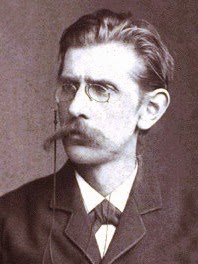
In the nineteenth century the discoveries of Charles Darwin not only revolutionised science and introduced the idea of evolution into human thinking, they also changed literature inspiring authors to a new approach to fiction writing. One of the first in Northern Europe to break with Romantic narrative tradition and to begin telling stories in a naturalistic style that showed man as a beast driven by instincts and urges was Danish botanist and writer Jens Peter Jacobsen (»»» read my author’s portrait). After his successful literary debut with a short story, he published in 1876 the historical novel Marie Grubbe. A Lady of the Seventeenth Century (Fru Marie Grubbe. Interieurer fra det syttende Aarhundrede). It is loosely based on the true story of a Danish noblewoman who died in 1718.
Jens Peter Jacobsen introduces Marie Grubbe as a slim and delicate girl with luxuriant hair of dull gold strolling in the gardens of her father’s estate in Tjele in Jutland. She is fourteen years old, motherless and according to the housekeeper, who is also the mother of her illegitmate baby half-sister, she is stubborn and bad. When war with Sweden breaks out, her father takes Marie with him to Copenhagen wishing her to stay with her wealthy aunt there. In fact, the widowed aunt is well-connected with the Royal Court and men like Ulrik Frederik, the favourite illegitimate son of the King, frenquent her house. Marie, however, is a romanitc child and has a crush on the King’s brave half-brother who successfully defended the city against Swedish attack. By the age of seventeen Marie has turned into a pretty young woman with many courtiers and Ulrik Frederik is one of them. Since he is a handsome and very promising young man, Marie agrees to marry him although she loves him only “after a fashion”. After a quiet wedding they pass passably happy months together until the King calls Ulrik Frederik to arms against Spain and he gladly departs to prove himself in combat. Upon his return he is a different man. His violent behaviour, his heavy drinking and philandering repulse her, so she refuses herself to him. What follows are nearly ten years of constant fight that after many tribulations and interference of their families end in divorce after all. And Marie sets out on a journey to Paris with her brother-in-law and lover who leaves her as soon as he realises that she has used up all her money. Grudgingly she returns to live with her father on his estate in Tjele in 1773. After six years her father persuades her through different threats to marry Palle Dyre, a counsellor of justice to the King whom she despises. For ten years their lives are eventless except for “endless quarrelling and bickering, mutual sullenness and fault-finding”. Then the coachman Soren Sorensen Moller commonly known as Soren Overseer enters into her life. She is forty-six and he twenty-two years old…
The wild and headstrong Marie Grubbe who isn’t willing to content herself with being well provided for by just any suitable husband higher or equal in social status as her surroundings expect is sometimes called the Danish Madame Bovary, but having read both novels, I can make out only one similarity, namely the fact that the protagonists are women who driven by their longing for romantic love and happiness break social conventions. The plot isn’t particularly complex, the psychological depth, on the other hand, that Jens Peter Jacobsen lends his leading character is remarkable and outdoes even Gustave Flaubert in my opinion. In fact, much of the book’s charm lies in the skilful and meticulous depiction of the thoughts, emotions and unconscious urges of Marie Grubbe. Together with the precise and detailed illustration of scene, society and history it makes a gorgeous novel. To my great relief, Jens Peter Jacobsen’s writing style isn’t longwinded and flowery as that of many of his precursors and contemporaries which made the read very pleasant for me and amazingly modern too considering that the novel first appeared in 1876.
It goes without saying that the works of Jens Peter Jacobsen are all in the public domain by now although there may be newer translations that aren’t. Nonetheless, an English edition of Marie Grubbe can be downloaded for free from Project Gutenberg for instance.

 Log in with Facebook
Log in with Facebook 







